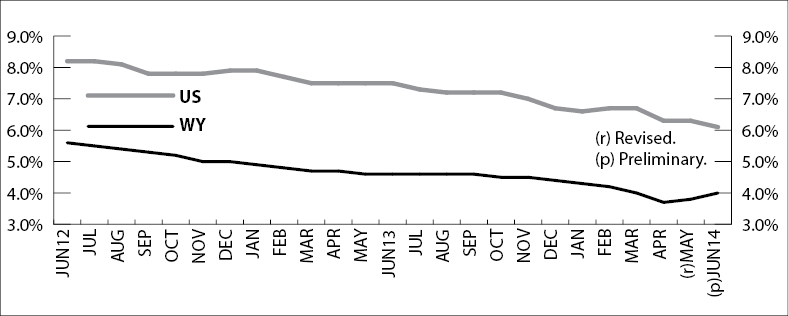
Wyoming Unemployment Rate at 4.0% in June 2014
The Research & Planning section of the Wyoming Department of Workforce Services reported that the state’s seasonally adjusted1 unemployment rose slightly from 3.8% in May to 4.0% in June 2014 (not a statistically significant change). Since March 2014, Wyoming’s unemployment rate has remained within the narrow range of 3.7% to 4.0%. Unemployment in Wyoming was much lower than its June 2013 level of 4.6%, and significantly lower than the current U.S. unemployment rate of 6.1%. Seasonally adjusted employment of Wyoming residents decreased slightly, falling by an estimated 822 individuals (-0.3%) from May to June.
Most county unemployment rates increased slightly from May to June. Unemployment sometimes rises in June as the school year ends and youths and other seasonal workers begin searching for work. The largest unemployment rate increases were found in Albany (up from 3.4% to 4.6%), Platte (up from 3.7% to 4.9%), and Weston (up from 3.7% to 4.6%) counties. Teton County’s unemployment rate fell from 5.7% to 3.3% as employers hired workers for the summer tourist season.
From June 2013 to June 2014, unemployment rates fell in 17 counties, were unchanged in three counties and increased in three counties. The largest decreases occurred in Sheridan (down from 5.0% to 4.4%), Campbell (down from 4.0% to 3.4%), and Teton (down from 3.8% to 3.3%) counties.
Fremont County posted the highest unemployment rate in June (5.5%). It was followed by Lincoln (5.1%), Big Horn (5.0%), and Johnson (4.9%) counties. The lowest unemployment rates were found in Teton (3.3%), Sublette (3.3%), Converse (3.4%), and Campbell (3.4%) counties.
Total nonfarm employment (measured by place of work) rose from 299,100 in June 2013 to 301,700 in June 2014, a gain of 2,600 jobs (0.9%).
Despite the recent growth, overall employment remained approximately 7,000 jobs (2.4%) below its fourth quarter 2008 level. In short, the state has yet to make up all the job losses of 2009 and 2010.
1Seasonal adjustment is a statistical procedure to remove the impact of normal regularly recurring events (such as weather, major holidays, and the opening and closing of schools) from economic time series to better understand changes in economic conditions from month to month.
